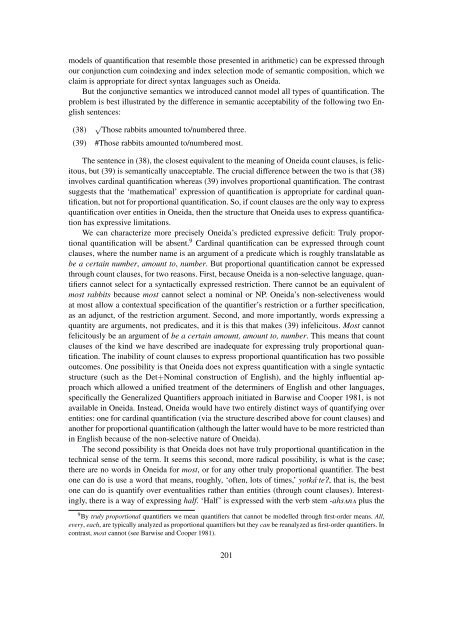Empirical Issues in Syntax and Semantics 9 (EISS 9 ... - CSSP - CNRS
Empirical Issues in Syntax and Semantics 9 (EISS 9 ... - CSSP - CNRS
Empirical Issues in Syntax and Semantics 9 (EISS 9 ... - CSSP - CNRS
You also want an ePaper? Increase the reach of your titles
YUMPU automatically turns print PDFs into web optimized ePapers that Google loves.
models of quantification that resemble those presented <strong>in</strong> arithmetic) can be expressed through<br />
our conjunction cum co<strong>in</strong>dex<strong>in</strong>g <strong>and</strong> <strong>in</strong>dex selection mode of semantic composition, which we<br />
claim is appropriate for direct syntax languages such as Oneida.<br />
But the conjunctive semantics we <strong>in</strong>troduced cannot model all types of quantification. The<br />
problem is best illustrated by the difference <strong>in</strong> semantic acceptability of the follow<strong>in</strong>g two English<br />
sentences:<br />
(38)<br />
√ Those rabbits amounted to/numbered three.<br />
(39) #Those rabbits amounted to/numbered most.<br />
The sentence <strong>in</strong> (38), the closest equivalent to the mean<strong>in</strong>g of Oneida count clauses, is felicitous,<br />
but (39) is semantically unacceptable. The crucial difference between the two is that (38)<br />
<strong>in</strong>volves card<strong>in</strong>al quantification whereas (39) <strong>in</strong>volves proportional quantification. The contrast<br />
suggests that the ‘mathematical’ expression of quantification is appropriate for card<strong>in</strong>al quantification,<br />
but not for proportional quantification. So, if count clauses are the only way to express<br />
quantification over entities <strong>in</strong> Oneida, then the structure that Oneida uses to express quantification<br />
has expressive limitations.<br />
We can characterize more precisely Oneida’s predicted expressive deficit: Truly proportional<br />
quantification will be absent. 9 Card<strong>in</strong>al quantification can be expressed through count<br />
clauses, where the number name is an argument of a predicate which is roughly translatable as<br />
be a certa<strong>in</strong> number, amount to, number. But proportional quantification cannot be expressed<br />
through count clauses, for two reasons. First, because Oneida is a non-selective language, quantifiers<br />
cannot select for a syntactically expressed restriction. There cannot be an equivalent of<br />
most rabbits because most cannot select a nom<strong>in</strong>al or NP. Oneida’s non-selectiveness would<br />
at most allow a contextual specification of the quantifier’s restriction or a further specification,<br />
as an adjunct, of the restriction argument. Second, <strong>and</strong> more importantly, words express<strong>in</strong>g a<br />
quantity are arguments, not predicates, <strong>and</strong> it is this that makes (39) <strong>in</strong>felicitous. Most cannot<br />
felicitously be an argument of be a certa<strong>in</strong> amount, amount to, number. This means that count<br />
clauses of the k<strong>in</strong>d we have described are <strong>in</strong>adequate for express<strong>in</strong>g truly proportional quantification.<br />
The <strong>in</strong>ability of count clauses to express proportional quantification has two possible<br />
outcomes. One possibility is that Oneida does not express quantification with a s<strong>in</strong>gle syntactic<br />
structure (such as the Det+Nom<strong>in</strong>al construction of English), <strong>and</strong> the highly <strong>in</strong>fluential approach<br />
which allowed a unified treatment of the determ<strong>in</strong>ers of English <strong>and</strong> other languages,<br />
specifically the Generalized Quantifiers approach <strong>in</strong>itiated <strong>in</strong> Barwise <strong>and</strong> Cooper 1981, is not<br />
available <strong>in</strong> Oneida. Instead, Oneida would have two entirely dist<strong>in</strong>ct ways of quantify<strong>in</strong>g over<br />
entities: one for card<strong>in</strong>al quantification (via the structure described above for count clauses) <strong>and</strong><br />
another for proportional quantification (although the latter would have to be more restricted than<br />
<strong>in</strong> English because of the non-selective nature of Oneida).<br />
The second possibility is that Oneida does not have truly proportional quantification <strong>in</strong> the<br />
technical sense of the term. It seems this second, more radical possibility, is what is the case;<br />
there are no words <strong>in</strong> Oneida for most, or for any other truly proportional quantifier. The best<br />
one can do is use a word that means, roughly, ‘often, lots of times,’ yotká . teP, that is, the best<br />
one can do is quantify over eventualities rather than entities (through count clauses). Interest<strong>in</strong>gly,<br />
there is a way of express<strong>in</strong>g half. ‘Half’ is expressed with the verb stem -ahs2n2 plus the<br />
9 By truly proportional quantifiers we mean quantifiers that cannot be modelled through first-order means. All,<br />
every, each, are typically analyzed as proportional quantifiers but they can be reanalyzed as first-order quantifiers. In<br />
contrast, most cannot (see Barwise <strong>and</strong> Cooper 1981).<br />
201











